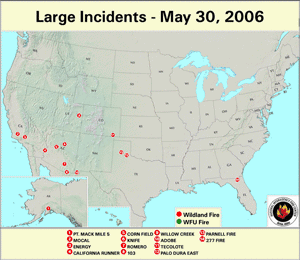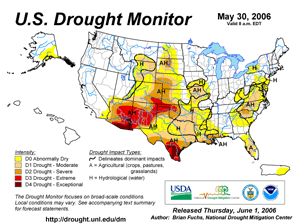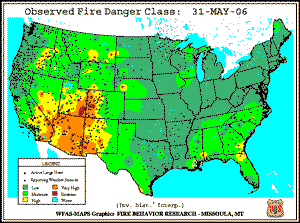Wildland fire activity increased during the past month across parts of the Southwest U.S., with fires developing in New Mexico in early May. Fires also developed in Southern California later in the month. In early June, fire activity began to affect parts of Alaska, with large fires developing in the Yukon Delta region.
Since the beginning of 2006, large fire activity focused primarily in the central and southern Plains, the Southwest and the Florida peninsula. As of June 7th, over 44,000 fires and over 2.6 million acres have burned across the contiguous U.S. and Alaska, according to estimates from the National Interagency Fire Center (NIFC). Of the total acreage, approximately 1.88 million acres have burned in the Southern Area (which encompasses 13 states, Puerto Rico, the Virgin Islands and the District of Columbia).
Fire activity also increased across Canada over the past month. As of May 31st, there have been 2180 fires and 41,807 hectares (103,307 ac) burned across Canada this year. For the latest information on the fire season in Canada visit the Canadian Interagency Forest Fire Center (CIFFC) website.
| Totals as of early June | Nationwide Number of Fires | Nationwide Number of Acres Burned |
|---|---|---|
| 6/7/2006 | 44,186 | 2,647,575 |
| 6/7/2005 | 25,647 | 449,746 |
| 6/7/2004 | 32,789 | 564,973 |
| 6/7/2003 | 22,509 | 425,870 |
| 6/7/2002 | 32,541 | 1,270,443 |
| 6/7/2001 | 34,760 | 738,314 |
| 6/7/2000 | 43,713 | 1,190,304 |
Dead fuel moisture levels were very dry at the end of May. The 10–hour fuel moisture levels on May 29th were extremely dry, with the observed levels below 5% across most of the High Plains, Great Basin, and Southwest states.
Medium to larger fuels (i.e., the May 31st 100–hr and May 31st 1000–hr fuel moistures) also remained unusually dry over the past month, especially in Arizona, New Mexico, western Texas, and the western slope of Colorado.
The Keetch–Byram Drought Index (KBDI), a widely used index for fire risk, had the largest potential for wildland fire activity in the contiguous U.S. across parts of the Southwest, southern Texas, and Florida at the end of May. In addition, the observed Experimental Fire Potential Index at the end of May was also anomalously high for a large area of the Southwest.
For further information on drought conditions across the U.S. please visit the May drought summary page.
 NOAA's National Centers for Environmental Information
NOAA's National Centers for Environmental Information


